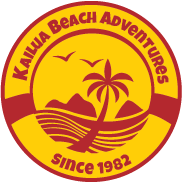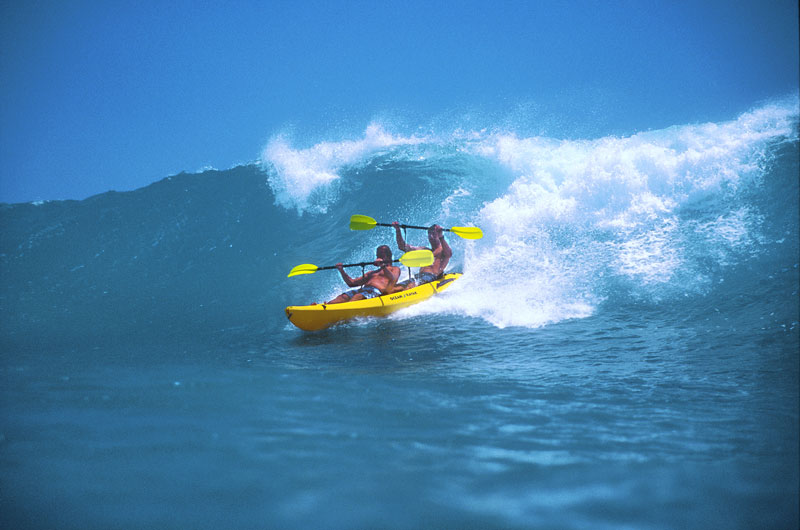
Kayaking in Hawaii
Your Guide to exploring the hawaiian islands by kayak
Hawaii: A paddler’s paradise
Kayaking has become one of the most popular watersport activities in Hawaii, and for good reason. The rich paddling heritage of the Hawaiian Islands, dating back to the Polynesian voyagers who first discovered the archipelago in sailing canoes, is deeply intertwined with the culture here. With over 750 miles of coastline, there is no shortage of stunning places to explore by kayak—from tranquil bays to open ocean paddles with views that will take your breath away.
The Hawaiian Islands have over 750 miles of coastline.
However, while kayaking in Hawaii can be an exhilarating experience, it's important to remember that the ocean is as unpredictable as it is beautiful. The waters around the islands can be treacherous, especially for those unfamiliar with the local conditions. Strong currents, tides, and sudden weather changes can challenge even the most seasoned paddlers. That's why safety should always be a priority, and it's crucial to make informed decisions before you set out.
How to Choose Your Kayaking Destination in Hawaii:
Understand the Conditions
Every beach, bay, and cove in Hawaii has unique ocean conditions that change daily—sometimes hourly. Before deciding where to kayak, make sure to check the latest weather reports and ocean forecasts. Wind direction, wave height, and tide changes can significantly affect your experience, so it's best to choose a location with calm waters, especially if you’re new to kayaking. Websites like NOAA’s Marine Forecast are great tools to use when planning your trip.Assess Your Skill Level
The location you choose should always align with your kayaking experience. If you’re a beginner or casual paddler, opt for sheltered bays and calm waters, such as Kailua Bay or Kaneohe Bay, which offer incredible scenery without the challenge of open ocean swells. For experienced paddlers, places like Mokulua Islands or Mokoli'i (Chinaman’s Hat) can be thrilling, but the currents and wind can make these trips much more difficult.Go with Knowledgeable Locals
We highly recommend paddling with a guide or experienced waterman who is familiar with the area where you're planning to kayak. Local guides understand the intricacies of Hawaii’s ocean conditions and can anticipate changes that may not be obvious to the untrained eye. They can also help ensure you’re paddling in a location that suits your skill level and can provide insight into the island's natural and cultural history, making your trip more enriching.Use Proper Gear and Be Prepared
Kayaking may seem simple, but it’s important to have the right equipment. Make sure your kayak is appropriate for the type of water you’ll be navigating. For calm bays, a sit-on-top recreational kayak may be enough. However, if you’re heading out into more challenging conditions, you’ll need a more seaworthy kayak with the proper safety gear, including a life jacket, leash, and communication device.Be Mindful of Wildlife and Marine Sanctuaries
Hawaii’s waters are home to a wide variety of marine life, and many areas are designated marine sanctuaries. When choosing your paddling destination, make sure you’re aware of any restrictions or guidelines for wildlife protection. It’s important to give sea turtles, monk seals, and other creatures plenty of space and to respect the fragile ecosystems you're paddling through.
Remember, the ocean is a powerful force that demands respect. Even if you're an experienced kayaker elsewhere, Hawaii’s ocean conditions can surprise you. That’s why it's so important to be aware of the environment, assess your abilities honestly, and make decisions that prioritize your safety.
Renting a Kayak
Most kayak rentals in Hawaii are sit-on-top and self bailing. A sit inside kayak, with a spray skirt, is not necessary, because Hawaii’s year round water temperature remains around seventy degrees Fahrenheit. A sit-on-top is also much safer to have as will not fill with water. For this reason, very few decked or sit inside kayaks can be found in Hawaii’s rental fleets. *A “scupper hole” is the term for the hole in which the water drains from the deck.
Guided Kayak Tours
There are many reasons to join a guided tour but we will limit it to two main reasons.
For your own safety and enjoyment. Hawaii is paradise but its also know for trade winds and surfing. Even if you have experience kayaking in rivers and lakes, it may not prepare you for kayaking in the Pacific.
It will be amazing! Going on your own might be safe but you will miss out on a much more complete experience. The culture and history of Hawaii is one that everyone should learn from a local. Whether its knowing the secret spots where the sea turtles hang or how the Ko`olau Mountains were formed, you will have more enriched trip with a kayak guide.
Kayaking in Hawaii: Top Destinations Across the Islands
Kayaking in Hawaii is a magical experience, offering breathtaking views of pristine waters, rugged coastlines, and abundant marine life. Each Hawaiian island has its own unique spots to explore by kayak, making it the perfect adventure for both beginners and seasoned paddlers. Here’s a guide to some of the best kayaking destinations across the Hawaiian Islands.
Oahu
Kailua Bay and the Mokulua Islands Kailua Bay is one of the most popular spots for kayaking on Oahu. The bay’s calm turquoise waters are perfect for beginners, and the scenic journey takes you to the Mokulua Islands, also known as "The Mokes." These twin islands are protected bird sanctuaries, and one of them, Moku Nui, has a small beach where kayakers can stop and explore.
Kaneohe Bay and Mokoli’i (Chinaman’s Hat) For a less crowded experience, Kaneohe Bay offers excellent kayaking conditions and is home to Mokoli’i (Chinaman’s Hat), famous for its stunning vista views at the top of the island.
There’s many other iconic paddling destinations on Oahu. Click here to check out our most comprehensive guide for kayaking on Oahu.
Maui
Molokini Crater Molokini Crater, located just off the southern coast of Maui, is a world-famous snorkeling and diving spot. The crescent-shaped, partially submerged volcanic crater creates a calm interior lagoon with crystal-clear waters. Though it’s more commonly accessed by boat tours, advanced kayakers can paddle the 3-mile journey from Maui’s coastline to Molokini for an unforgettable adventure.
Makena Landing Makena Landing is a great launch point for kayaking in South Maui. Paddlers can explore the nearby reefs, spot Hawaiian green sea turtles (honu), and, if you’re lucky, witness a humpback whale during the winter months. The coastline here is stunning, with volcanic rock formations and hidden coves to discover.
Kauai
Wailua River Kauai’s Wailua River offers a unique kayaking experience as it is one of the few navigable rivers in Hawaii. Kayakers can paddle upriver through lush tropical landscapes, making their way to the stunning Secret Falls (Uluwehi Falls). This gentle river is perfect for beginners, and the journey feels like a step back in time to ancient Hawaii.
Napali Coast For experienced paddlers, the Napali Coast is a must-see. This iconic coastline is characterized by towering cliffs, waterfalls, and sea caves that are only accessible by water. A kayaking trip along this rugged stretch of coastline offers incredible views, along with opportunities to see dolphins, sea turtles, and even monk seals. However, due to strong ocean currents and challenging conditions, it’s best done with a guided tour.
Big Island (Hawaii Island)
Kealakekua Bay Kealakekua Bay, on the western side of the Big Island, is a marine life conservation district known for its clear waters and abundant marine species. It’s also home to the Captain Cook Monument, which marks the spot where the famous explorer first landed in Hawaii. Kayaking across the bay gives you the chance to see spinner dolphins, colorful coral reefs, and schools of tropical fish.
Hilo Bay For a more laid-back kayaking experience, Hilo Bay offers calm waters and views of Mauna Kea in the distance. Paddlers can explore along the bay’s coastline or venture to Coconut Island (Moku Ola), a small, tranquil island where you can take a break and enjoy the lush surroundings.
Hawaii Kayaking Safety Tips
Know Your Limits: Always choose a kayaking route that matches your skill level, especially in Hawaii where conditions can change rapidly. Its always better not to go out if you’re not sure then go out and get into trouble.
Check Conditions: Hawaiian waters can be unpredictable. Make sure to check ocean conditions and wind forecasts before heading out. Even still, forecasts are not full-proof, so go out with an experienced guide.
Bring the Essentials: Don’t forget to pack plenty of sunscreen, water, snacks, cellphone, and a waterproof dry bag for your belongings.
Respect Wildlife: Keep a safe distance from marine life, especially endangered species like Hawaiian monk seals, sea turtles, and nesting seabirds that you may come across.
kayak surfing
kayak surfing
Kayak surfing is a great way to combine Hawaii’s beautiful waters with its year round waves. Kayak surfing is generally for more experienced paddlers but can be attempted under supervision by an expert in smaller waves on your first day. The rush of catching a wave in a kayak is unforgettable. Sit-on-top kayaks are perfect for kayak surfing because they can be easily flipped over if a wave tips you over. The larger person should be in the back seat and the person in the front should lean back!
Conclusion
Whether you’re gliding over calm bays or paddling through rougher seas, kayaking in Hawaii offers unparalleled views and an intimate connection with the islands’ natural beauty. Each island has its own hidden gems to discover, so be sure to explore them on your next visit!
Planning a trip to Hawaii? Reserve a kayak or book a guided kayak tour and get ready for the adventure of a lifetime! 🌊🌴



